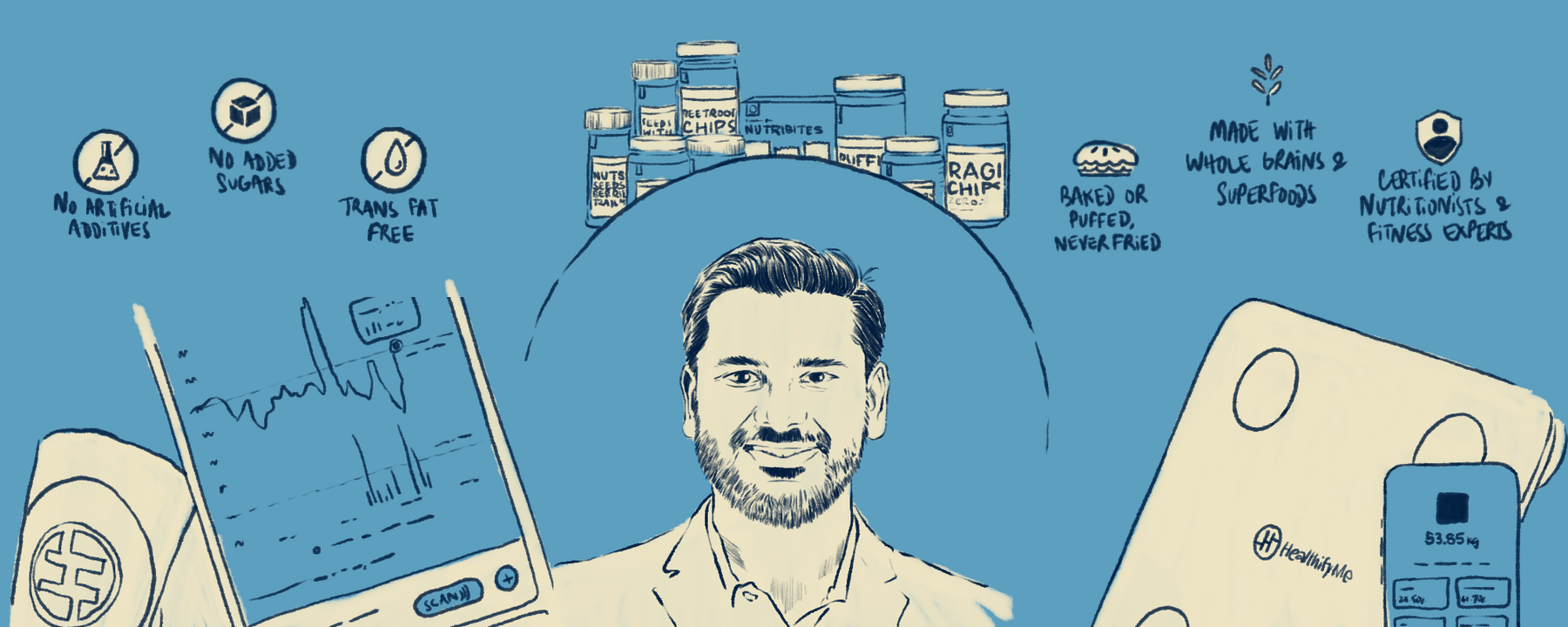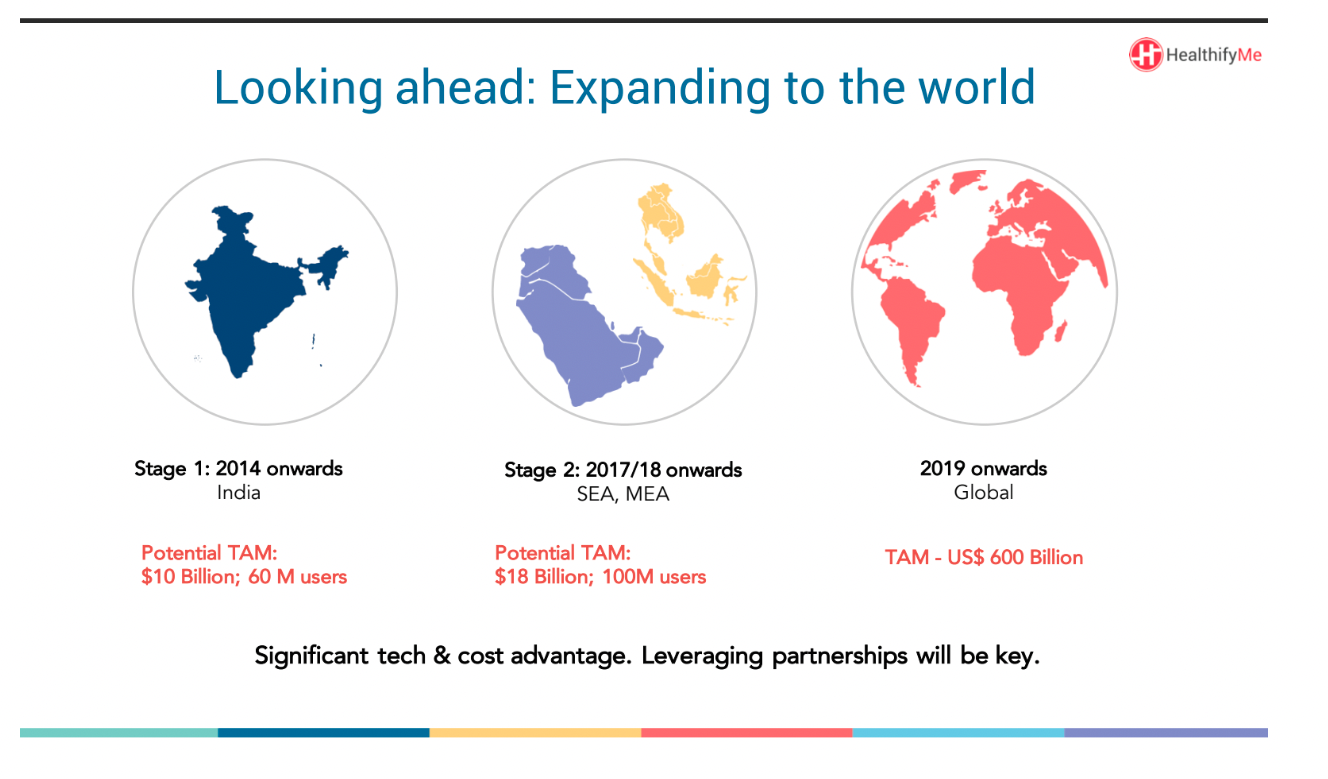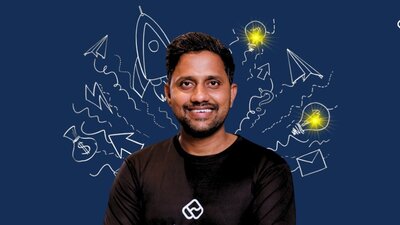If you ask ChatGPT to create a diet plan for you, it does an excellent job of creating a detailed line-up of healthy meals along with recipes. But there are numerous risks involved in listening to an AI that has no input from a healthcare professional.
ChatGPT recognizes its limitation as it adds a warning at the end of such an answer: “Remember to consult with a healthcare professional or a registered dietitian if you have specific dietary concerns or requirements.”
This is where HealthifyMe, an AI-led healthtech platform differs from a generic chatbot trained on internet data. The place where ChatGPT’s capabilities end, HealthifyMe begins. Enter, a mix of both intangible and tangible capabilities in the form of an expertly trained AI coach and accompanying health tracking tools.
The 11-year-old healthtech startup HealthifyMe, founded by Tushar Vashisht, uses AI as well as the knowledge and experience of healthcare professionals like nutritionists and fitness trainers, to guide users to live a healthy life.
What makes HealthifyMe unique in India’s fledgling US$2 billion-plus healthtech industry is its reliance on evidence-based data. The company knew that without users’ accurate health data, it would not be possible for its health coaches or Ria to come up with the proper health and nutrition plans. Mind you, Ria walked before ChatGPT could run now. To remove the burden on users for punching in their accurate weight and other health parameters, it created a robust ecosystem of connected devices and services. This includes a smart weighing scale, continuous glucose monitor, and third-party partnership for blood tests.
Ever since COVID-19, people have become more health conscious and eager to improve their daily lifestyles like eating healthy and exercising. HealthifyMe’s founder Tushar believes his healthtech startup can bring about this change in people with AI’s alacrity, and the years of experience of its 1,000 health coaches.
As of now, the company has a total user base of 35 million who benefit from HealthifyMe’s AI capabilities.
Counting Calories
Starting a healthtech company hadn’t crossed Tushar’s mind until he came to India to work with the Unique Identification Authority of India (UIDAI) in 2010.
Joining UIDAI was his passionate attempt to leave his cushy job at Deutsche Bank in San Francisco and return to India. Tushar comes from a family that has always worked in the public service sector. So, he was looking for a “meta-level purpose” that he “could strongly resonate with.”
It was during the time when Aadhar had begun to take off that Tushar knew it would be the next big thing to impact Indians. He just had to join the team. He was tested in a series of interviews and finally got selected. He agreed to work with UIDAI without any salary as long as his food and stay were taken care of.
Now comes the story of how he stumbled upon the idea of starting HealthifyMe.
While working at UIDAI’s public distribution arm, which included food and nutrition, Tushar and his friend and roommate from UIDAI, Mathew Cherian, ran an experiment to understand how less privileged people eat and manage their daily nutritional intake.
They decided to live on INR 100 a day, the daily average Indian income, for three weeks, and, then for a week on INR 32 a day, which was the minimum daily earnings requirement for a person to be considered living above the poverty line. With limited money to spend on everything, Tushar started calculating his nutrition and calorie intake on an Excel sheet.
That Excel sheet soon became a template for others to track their own calorie intake. Seeing its popularity, Tushar teamed up with Mathew and ported his calorie tracker onto a website so that more people could use it.
Tushar and Mathew had already made up their minds to co-found a business that could have a positive impact on people’s lives. As the website started getting used by lakhs of people, they saw a business opportunity in this. HealthifyMe was born.
“As we built that website, people started loving it and wanted more. Our goal was to first create a nutrition tracker for India. Maybe if we could help people track (their calorie count), we could help people improve,” says Tushar, who is the CEO of HealthifyMe.
It was this first version of their website that impressed angel investors to write HealthifyMe a check of INR 1 crore in 2012.
Going Down Before Going Up
While they had received angel funding based on the website and the nutrition tracker, Mathew and Tushar hadn’t come up with a business model yet.
To distribute the tracker to people who needed it the most, they partnered with hospitals hoping patients who visit doctors to fight diabetes or obesity would find it useful.
The company started onboarding doctors and their patients in its network. While people loved the calorie tracker, this model didn’t take off the way the founders expected.
B2B sales can be very hard for a small brand, and HealthifyMe could only manage some 7-8 hospitals and a few corporates as their clients. When they couldn’t scale it beyond a certain point, which eventually marked the end of its two-year-old B2B offering.
After two years of running HealthifyMe as a B2B company, Tushar decided to take the nutrition tracker directly to customers in 2014 as a mobile app. This move solved the scalability issue, as people really took to the app. But since the service was free the company was soon running thin on the INR 1 crore it had raised in 2012.
However, the INR 1 crore seed funding was almost over, and the company’s finances were thinning.
“On one hand, our app had thousands of users, who were loving us. On the other hand, there was simply no revenue model. There was one through hospitals, which wasn't scaling. We went completely out of money and survived for three to four months with no salaries or cash,” Tushar remembers.
Tushar was stuck between a rock and a hard place: a B2B model with extremely long sales cycles and limited clients, and a B2C model that garnered users but not revenue.
Between 2012 and 2014, Tushar says he went through two dichotomous emotions: the joy of creation and disappointment at being unable to build a formidable business.
“But as a young person and a fresh founder, there was much energy, which powered us.”
Tushar took a loan and reincorporated the company in Singapore to start afresh. This time he started focusing on building the B2C model. Unlike the previous version, where the nutritionists’ services were sold to hospitals, Tushar started offering their services directly to consumers. On top of it, he added fitness trainers to the company’s pool of healthcare professionals.
“I think being pushed against the wall forced us to rethink and innovate. 2014 was a period of transition for us. It was the sunset of one model and the sunrise of another. All of our revenue, business, and everything started to pick up only in early 2015,” says Tushar.
As a result of this pivot, it raised a seed round of USD 800,000 in 2015.
Productizing Health
With so many ups and downs, Tushar had finally steered HealthifyMe in the right direction. Now, all the company needed was to build upon its existing services.
Between 2015-2017, he made tweaks here and there, experimenting with the services to see if their offerings could be improved and if more margins could be claimed.
HealthifyMe was able to reach a 26% gross margin, but Tushar wasn’t satisfied with it.
“We knew that we can't be a 26% gross margin company and we can't just have nutritionists and trainers servicing clients. We needed to productize a lot,” Tushar remembers.
In 2016, HealthifyMe raised USD 6 Mn in its Series A round of funding. To aid nutritionists and trainers handle more users, Tushar invested a part of this investment in developing AI capabilities.
By 2019, HealthifyMe had created a consumer-facing chatbot called Ria. It was one of the first few companies to have a conversational bot that could comprehend text messages from users, and make sense of it to help health coaches create comprehensive plans for customers.
Its AI models, which were trained on the company’s massive database, were so impressive that by 2019-2020, half of its subscribers were using its AI-only offering.
“The other half of our subscribers were using human coaches, who were levered heavily by AI,” says Tushar.
As the company transformed its healthcare services with AI, it managed to increase its gross margin from 26% to over 70%.
“We are now a very high gross margin company. And that's why the 2017-19 evolution was probably the most significant in our history so far,” he adds.
This is also a period when they almost doubled the revenue each other. They started with USD1Mn in 2017, then roughly USD3Mn in 2018, to now, when the company is expected to cross USD40Mn in January.
With more and more users opting for its technology product, which is the AI chatbot, Tushar now feels that HealthifyMe has graduated from a services company to a product-first and services-second company. With Ria, the company was able to improve conversion rates significantly - from 2-3% paying subscribers of the MAU it grew to 6-7% of the MAU. Today, HealthifyMe is at 10%.
“I think we are a product service company,” he says.
Karthik Reddy, Co-founder and Partner at Blume Ventures, believes that adding technology layers to make a service superior and non-generic is the key to success in the healthtech industry. And HealthifyMe has mastered that play.
In HealthifyMe, he also sees a compelling proposition solving for something that existing local and global players are ill-equipped to do.
India’s nascent healthtech industry lacks integration and standardization, which results in inconsistencies in patients’ medical results, notes a KPMG report. HealthifyMe’s data-driven approach to building a digital health and fitness ecosystem plugs these gaps. The other key challenge for healthtech players is to make their services affordable while keeping the quality and margins intact. AI is the key to achieving that, which is where Tushar thrives.
HealthifyMe’s next spurt of growth came in 2020.
At the time when COVID-19 was at its peak, the company launched Healthify Studio, an online live workout solution. Since people couldn't go to fitness centers, HealthifyMe gave them an alternative.
“Even now people continue using the studio. We recently organised an all-day yoga-thon and thousands of people joined in,” Tushar says.
By the time pandemic subsided, people’s attitudes toward health, taking care of themselves, and eating behaviour had changed for good. Increasingly, people started to invest in their health and wellness, and they became conscious of what they were eating, how much they were eating, and how much they were working out.
The change in behaviour fast-paced HealthifyMe’s growth as customers came pouring in.
“We didn't have to convince people. People started to download our app and engage with it more organically. They realized it themselves that healthy and conscious living should be an important part of their lifestyle. Since Healthify helps in habit formation focusing on a better lifestyle, nutrition, and fitness, it became really prevalent,” Tushar explains.
During the pandemic, its app usage saw a monumental rise, which simmered down a bit post-pandemic. However, the company is seeing a much higher user uptick compared to the pre-pandemic period.
“Metrics like organic downloads, usage, engagement, and retention are much better than the pre-pandemic days.”
The Growth Chart
The subscription model, which HealthifyMe bets on, has been showing staggering growth.
Users can choose either to subscribe to the AI coach, which costs about INR 800 a month, or go for AI-plus-human coach subscriptions, which start at INR500 a month. In addition, consumers can use the app for free, albeit with limited usability.
“Integrating AI into the product allows for it to be available at a much more affordable price point since it doesn't involve human effort,” says Karthik from Blume Ventures. “And it's getting more sophisticated and becoming an add-on to the premium customers who may want personal advice, counseling, and care.”
There are about a quarter million paying users, of which, half subscribe to HealthifyMe’s AI-only bot Ria, and the other half subscribe to Ria-assisted-human health coaches.
While the company enjoyed healthy subscription growth, it kept innovating its business model to make way for HealthifyMe 2.0.
The idea behind HealthifyMe 2.0 was rooted in three strong motives—add features or services that help coaches serve users better; diversify business models to rake in more revenue; and lastly, put HealthifyMe on a perpetual growth journey.
To ensure that the company is on an ever-climbing growth journey, Tushar wanted to diversify the business model in a way that not only rakes in more revenue but also to helps coaches serve users better.
Integrated devices, evidence-based coaching, and creating an ecosystem for healthy living were a few areas in which Tushar decided to expand into.
He was already aware that users who give the most accurate data were getting better results because coaches were able to suggest them better. This led him to launch health devices like smart scale and continuous glucose monitors (CGMs). The company also integrated metabolic panels into the app based on blood tests, which it has tied up with diagnostics chains.
The data from the smart devices and blood work goes directly into users’ accounts on the app. This allows coaches and AI models to understand users’ profiles better.
“The more data our consumers share with us, the better our advice and recommendations are. Our nutritionists and trainers are always striving for that,” Tushar says.
As a part of the plan to create an ecosystem for consumers looking for healthy living, the company is also experimenting with healthy food, which includes staples, snacks, and supplements.
“It's in a beta stage. We are exploring the idea by getting feedback and assessing whether this is viable and something we should do. If we decide to do it, we hope to launch an actual food portfolio in the next two to three months,” Tushar says.
What long-term health will look like
For the last two years, HealthifyMe was in a phase where it added a lot of integrated technologies to improve data accuracy and have more data types. Now Tushar wants to make HealthifyMe’s entire offering packed into a completely new re-imagined AI-driven, multilingual and multimodal product.
“It will be powered by the combined capabilities of generative AI and human coaching, backed with all our data from the last 11 years. It should be the simplest and easiest app in the world to track your lifestyle. And it should be the most mind-blowing app in terms of getting insights and advice from,” Tushar explains.
HealthifyMe is already present in other countries and offers localized services in Southeast Asian countries. In fact, Indian expats living overseas contribute 15% to its revenue.
Now, HealthifyMe wants to offer localized services around the world with the help of AI. In that order, it’s looking at expanding to the US, the UK, the Middle East, and Latin America.
“We are earning about USD 30-40 Mn a year. India has good profitability. We know our India revenue will eventually reach USD 100 million plus over the next three years,” Tushar says.
He believes India’s online health and fitness market, which HealthifyMe helped create, is worth about USD 120 million (INR 1,000 crore) a year. HealthifyMe has already claimed a quarter of it.
Tushar expects this market to cross a billion dollars (INR 7,000-8,000 crores) by 2028. And his aim is to continue retaining a 20-30% share of that.
“The bigger question is, how can we use AI to launch in multiple countries?” he says.
Tushar is eyeing USD 500 Mn topline in the next five to seven years, driven by overseas expansion, and finally fulfilling his mission of healthifying a billion people. About half of it is expected to come from India.
For Karthik, it became clear five years ago that HealthifyMe was not designed to be an India-only product. Its technology, design, UI, UX, and eventual premiumisation, all of it showed signs of being a global product. Blume first invested in HealthifyMe from Fund 2. The company has raised USD130Mn+ over ten rounds over the years.
“HealthifyMe can use its digital-first, AI-first approach and engineering and cost efficiencies from the Indian model to get customers globally with very little operational interventions,” says Karthik. “Its ability to premiumize the product using AI, at a cost structure that is different from its global peers in the US, will be a useful advantage.”
With hypergrowth being Tushar’s main agenda, he sticks by the mantra given by Blume Ventures – Apna Kaam Karo (AKK).
“They have this hashtag #AKK, which means keep doing your work and don't worry about noise. As long as you keep focusing on customers and products, and keep innovating, there’s nothing to worry about.”









